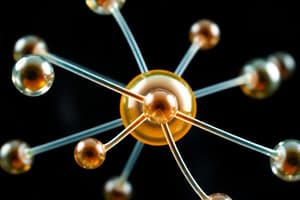Podcast
Questions and Answers
What is the smallest unit of matter that defines the chemical elements?
What is the smallest unit of matter that defines the chemical elements?
- Molecule
- Atom (correct)
- Nucleus
- Electron
What is an electron?
What is an electron?
A subatomic particle that is negatively charged and cannot be broken down into anything smaller.
What is the definition of a nucleus?
What is the definition of a nucleus?
The positively charged central core of an atom, consisting of protons and neutrons.
What charge does a proton have?
What charge does a proton have?
What is a neutron?
What is a neutron?
What does the atomic number represent?
What does the atomic number represent?
Define an isotope.
Define an isotope.
What is the mass number?
What is the mass number?
What is the periodic table?
What is the periodic table?
What is meant by 'period' in the periodic table?
What is meant by 'period' in the periodic table?
What is a chemical symbol?
What is a chemical symbol?
What are characteristics of metals?
What are characteristics of metals?
What does it mean if a metal is malleable?
What does it mean if a metal is malleable?
What is thermal conductivity?
What is thermal conductivity?
What is electrical conductivity?
What is electrical conductivity?
Define reactivity in chemistry.
Define reactivity in chemistry.
What is corrosion?
What is corrosion?
What are alkali metals?
What are alkali metals?
What are alkaline earth metals?
What are alkaline earth metals?
What defines transition metals?
What defines transition metals?
What is a particle accelerator?
What is a particle accelerator?
Define nonmetals.
Define nonmetals.
What is a diatomic molecule?
What is a diatomic molecule?
What are halogens?
What are halogens?
What is an inert gas?
What is an inert gas?
What is a semiconductor?
What is a semiconductor?
Flashcards are hidden until you start studying
Study Notes
Basics of Atomic Structure
- Atoms are the smallest units of matter, comprising all states such as solids, liquids, gases, and plasmas.
- The atom consists of a nucleus surrounded by electrons.
- The nucleus contains positively charged protons and neutrally charged neutrons, holding almost all atomic mass.
Subatomic Particles
- Electrons are negatively charged, elementary particles that move near the speed of light. They participate in various interactions including electromagnetic and gravitational.
- Protons carry a positive charge (+1e) and have a mass slightly less than neutrons.
- Neutrons have no electric charge and are slightly heavier than protons.
Atomic Fundamentals
- The atomic number corresponds to the number of protons in the nucleus and defines the element.
- Isotopes are variants of elements that differ in neutron count.
- The mass number represents the total count of protons and neutrons (nucleons) in the nucleus.
The Periodic Table
- Elements are organized in a periodic table based on atomic numbers, electron configurations, and chemical properties.
- Periods in the table are rows indicating elements with increasing atomic numbers, while groups (or families) are columns of similar properties.
- Each element has a unique chemical symbol, often derived from its Latin name.
Properties of Metals
- Metals, located to the left of a stair-stepped line on the periodic table, exhibit high electrical and thermal conductivity.
- Highly reactive metals include alkali metals (Group 1), which can explode upon contact with water.
- Alkaline earth metals (Group 2) are also reactive but not found freely in nature due to their reactivity.
Characteristics of Metals
- Malleability refers to materials that can be shaped without breaking, while ductility allows metals to be drawn into wires.
- Thermal conductivity is the ability of a material to conduct heat, and electrical conductivity measures how well a material can conduct electricity.
- Corrosion describes the gradual destruction of metals due to environmental reactions, typically involving oxidation.
Types of Elements
- Transition metals (Groups 3-12) are known for their ductility, malleability, and electrical properties; notable examples include iron, cobalt, and nickel.
- Nonmetals (Groups 14-16) are generally poor conductors of heat and electricity, existing mainly as gases or brittle solids at room temperature.
- Diatomic molecules consist of two atoms of either the same or different elements (e.g., H2).
- Halogens (Group VIIA) are highly reactive, diatomic elements, often forming salts when combined with metals.
Specialized Categories
- Inert gases are non-reactive under specific conditions, often referred to as noble gases.
- Semimetals (metalloids) possess properties of both metals and nonmetals, while semiconductors can conduct electricity under certain conditions but behave like insulators otherwise.
Studying That Suits You
Use AI to generate personalized quizzes and flashcards to suit your learning preferences.




